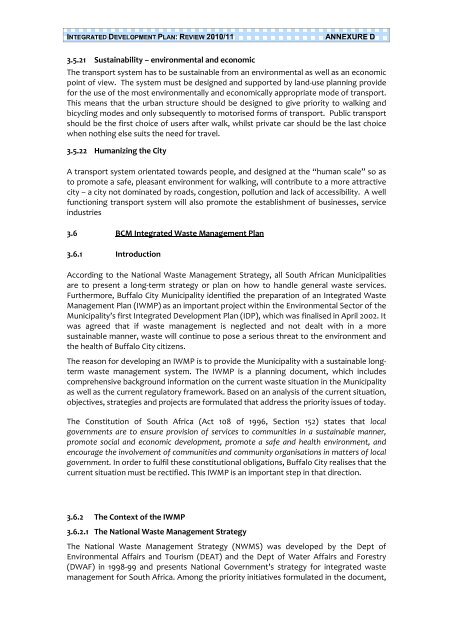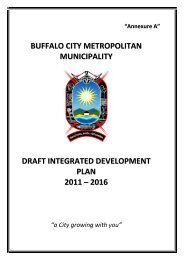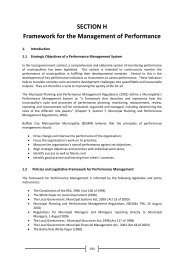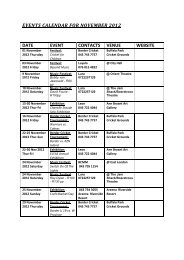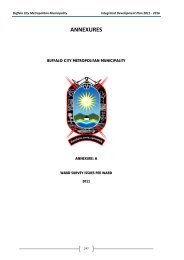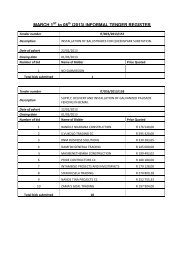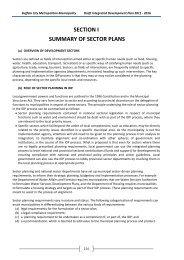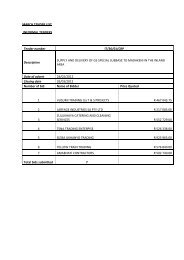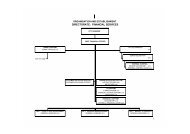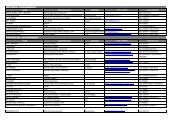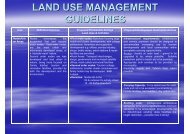annexure d executive summary of bcm sector plans - Buffalo City
annexure d executive summary of bcm sector plans - Buffalo City
annexure d executive summary of bcm sector plans - Buffalo City
You also want an ePaper? Increase the reach of your titles
YUMPU automatically turns print PDFs into web optimized ePapers that Google loves.
INTEGRATED DEVELOPMENT PLAN: REVIEW 2010/11ANNEXURE D3.5.21 Sustainability – environmental and economicThe transport system has to be sustainable from an environmental as well as an economicpoint <strong>of</strong> view. The system must be designed and supported by land-use planning providefor the use <strong>of</strong> the most environmentally and economically appropriate mode <strong>of</strong> transport.This means that the urban structure should be designed to give priority to walking andbicycling modes and only subsequently to motorised forms <strong>of</strong> transport. Public transportshould be the first choice <strong>of</strong> users after walk, whilst private car should be the last choicewhen nothing else suits the need for travel.3.5.22 Humanizing the <strong>City</strong>A transport system orientated towards people, and designed at the “human scale” so asto promote a safe, pleasant environment for walking, will contribute to a more attractivecity – a city not dominated by roads, congestion, pollution and lack <strong>of</strong> accessibility. A wellfunctioning transport system will also promote the establishment <strong>of</strong> businesses, serviceindustries3.6 BCM Integrated Waste Management Plan3.6.1 IntroductionAccording to the National Waste Management Strategy, all South African Municipalitiesare to present a long-term strategy or plan on how to handle general waste services.Furthermore, <strong>Buffalo</strong> <strong>City</strong> Municipality identified the preparation <strong>of</strong> an Integrated WasteManagement Plan (IWMP) as an important project within the Environmental Sector <strong>of</strong> theMunicipality’s first Integrated Development Plan (IDP), which was finalised in April 2002. Itwas agreed that if waste management is neglected and not dealt with in a moresustainable manner, waste will continue to pose a serious threat to the environment andthe health <strong>of</strong> <strong>Buffalo</strong> <strong>City</strong> citizens.The reason for developing an IWMP is to provide the Municipality with a sustainable longtermwaste management system. The IWMP is a planning document, which includescomprehensive background information on the current waste situation in the Municipalityas well as the current regulatory framework. Based on an analysis <strong>of</strong> the current situation,objectives, strategies and projects are formulated that address the priority issues <strong>of</strong> today.The Constitution <strong>of</strong> South Africa (Act 108 <strong>of</strong> 1996, Section 152) states that localgovernments are to ensure provision <strong>of</strong> services to communities in a sustainable manner,promote social and economic development, promote a safe and health environment, andencourage the involvement <strong>of</strong> communities and community organisations in matters <strong>of</strong> localgovernment. In order to fulfil these constitutional obligations, <strong>Buffalo</strong> <strong>City</strong> realises that thecurrent situation must be rectified. This IWMP is an important step in that direction.3.6.2 The Context <strong>of</strong> the IWMP3.6.2.1 The National Waste Management StrategyThe National Waste Management Strategy (NWMS) was developed by the Dept <strong>of</strong>Environmental Affairs and Tourism (DEAT) and the Dept <strong>of</strong> Water Affairs and Forestry(DWAF) in 1998-99 and presents National Government’s strategy for integrated wastemanagement for South Africa. Among the priority initiatives formulated in the document,


